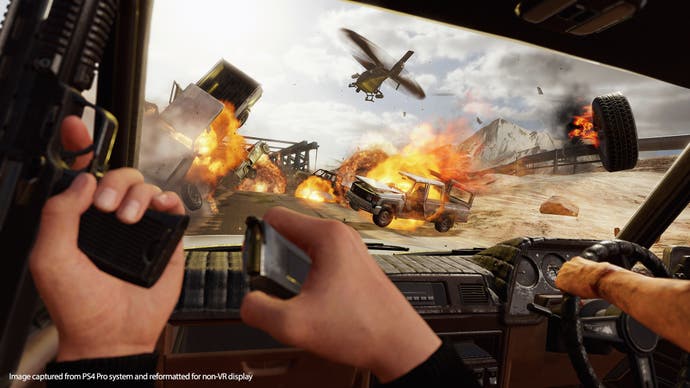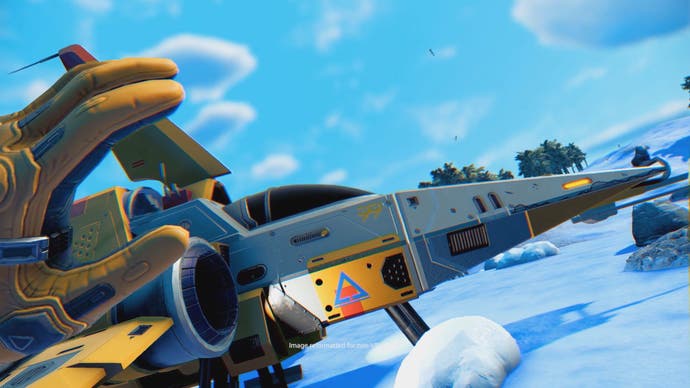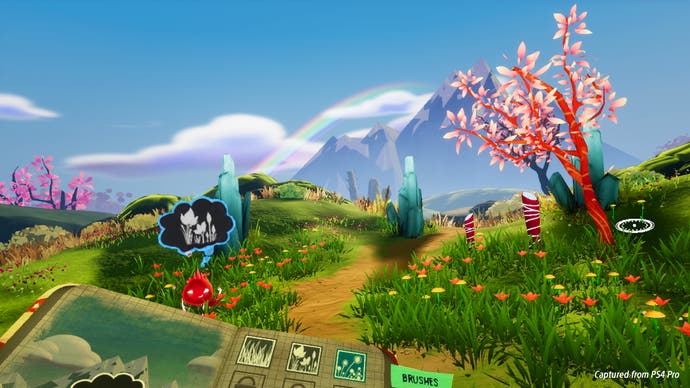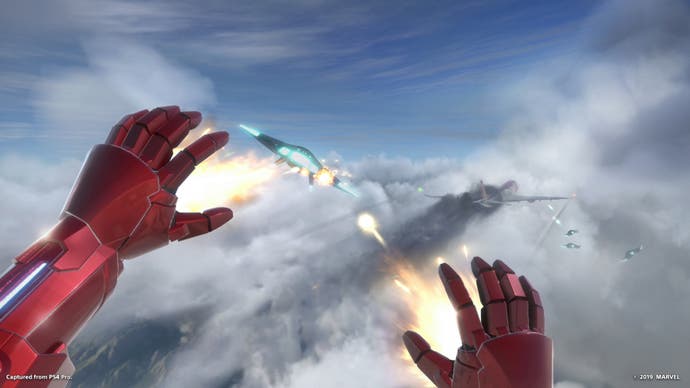Hands (and head) on with all the big upcoming PSVR releases for 2019
From Blood and Truth to Five Nights at Freddy's.
Before last week, I'd never been to New York but, as I wandered its streets and stared at its sights, it certainly felt like I had. New York is a city I've visited countless times in video games past. It's a place I associate with characters like Max Payne, the Ninja Turtles and the Ghostbusters. Years of dreaming and watching and then suddenly, after a relatively short flight, I was there, in glorious, real-world 3D, recognising locations I'd only ever experienced before on the flat screen of a monitor.
In hindsight this transition from video game setting to a place I could actually inhabit made New York the perfect metaphor for the thing that brought me there in the first place. And so, after a quickly swinging by the Ghostbusters building to do a spot of tourism, I popped in to Sony's PlayStation VR Spring Showcase to try out some of the biggest games that are bound for the system this year.
Blood and Truth

I've had my eye on Blood and Truth for a while now, so I'm not sure why I didn't realise the control scheme was teleport to move only. Not only that, but as it turns out, your character is only able to move to set locations around each level. So, as I hopped forward to the first of many mandatory teleport points during my hands-on demo, my mind flashed back to Bravo Team and I started to feel a little sad.
Thankfully, the dismay was short-lived as the action quickly ramped up. By the time I was catching grenades and lobbing them back at enemies who then exploded in glorious slow motion, all thoughts of the abysmal Bravo Team had vanished from my mind.
Blood and Truth runs on a brand new engine that's been made specifically for VR and, although you don't get the freedom of movement I was expecting, it does look like we're set to get a highly polished, good-looking action game with excellent pacing and some stunning set pieces.
The tutorial level starts with a short interrogation before flashing back to your character Ryan Mark's time in the army. After teaching you how to load your guns and pick a lock, the action builds, jumping the movement from on-rails to semi-on-rails as you strafe side to side between pieces of cover, popping up every now and then to shoot an advancing bad guy in the face.
It's in these moments of combat where you can see why the developers chose not to make the game free-roam. With the limitations of the Move controllers, moving Ryan between cover is much easier with a simple button press. It also allows you to reload your weapons easily or, as I mentioned before, snatch grenades out of the air in true, action-hero-style.
What's great about the game is that it doesn't keep you doing one thing for too long. After fighting your way to a friend who is held hostage, you pick the lock in his handcuffs and then escape, triggering what's called a 'run and gun' section. Here, the camera moves forwards on its own, as if Ryan is legging it at full speed across a series of rooftops. Without having to worry about movement at this point, you're free to concentrate on the shooting, which, as long as your aim is true, gives you an unstoppable action hero vibe.
The final section of the demo featured a high-speed chase along desert roads, your mate driving and taking the mickey out of you with some classic army banter, while you get busy shooting out the tyres and passengers of the approaching vehicles.
While it would have been nice for Blood and Truth to give you full freedom of movement, the trailer footage suggests that there is at least the option to toggle the camera so it glides to each movement node rather than teleporting. Still, even with full teleport selected, the way the game rockets you along from action-packed scene to action-packed scene (with a brief pause every now and then to add a bit of character and plot development) does indeed make you feel like you're staring in your own Hollywood movie.
With around 7-8 hours worth of game time in there for your first playthrough and lots of challenges to complete and weapon skins to unlock, Blood and Truth looks like it should be a quality experience for your PSVR. And it won't be long until we find out for sure though, because the game releases on May 28th.
No Man's Sky: Beyond VR

I'll keep this one relatively short as Martin covered the PC build of this extensively in his feature but I do have to say how incredible the simple act of exploring felt in No Man's Sky: Beyond VR. The sense of scale and wonder that you feel in the flat game is magnified beyond belief in VR and I can honestly imagine losing hours of my life to virtually touring the infinite reaches of space.
Visually the game looks wonderful in VR and aside from a few framerate stutters here and there I didn't notice too much of a downgrade in visual quality. The high point for me in the demo, though, was the terrain editing. Teleporting into a cave and then using my mining tools to carve a way out was as simple to perform as it was exciting and in VR, interacting with the environment in this way always made me feel like I was on the verge of making some kind of magnificent discovery.
Comfort-wise, I played the game using teleportation and snap turning to move but I was told that you can turn all of those off and play with smooth locomotion if you so wish. I would offer a word of warning to those less experienced in VR though. While flying in your ship out into space is impressive, the motion of it is pretty extreme and it could easily be a bit too much for beginners to handle. Even I felt a bit wobbly at one point as I got to grips with using my dual Move controllers as the ship's joystick and thrusters, so I can easily imagine others struggling with the intensity at first.
In the end, I only got to play around with No Man's Sky: Beyond VR for around 15 minutes but I can already tell you that it was everything I had hoped the game would have been on launch day and more. No Man's Sky Beyond VR will come as a free update sometime this summer and honestly, I can't wait.
Everybody's Golf VR

The closest I've come to playing actual golf in real life was when I got drunk and played Crazy Golf at Clarence Pier in Portsmouth during a trip to visit my brother. I seem to remember I was pretty good at it, but I'll put that down to the ales because when I played Everybody's Golf sober, I was terrible. Or at least, I was at the start. Turns out Everybody's Golf VR is really easy to pick up, even for noobs. I guess that's why it's called Everybody's Golf.
Thankfully the developer walking me through the short, two-hole demo was incredibly patient. Once he'd explained for around the fifth or sixth time that I didn't need to whack the ball as hard as I could, things started to click for me and I went from continually slicing the ball into the woods to pulling off quite a nice Birdie on the second hole.
Holding a single Move controller in both hands to mimic the grip on a golf club was pretty intuitive and with a simple button press I could cycle through my clubs to pick the best one for the job. Then I was able to take as many practice swings as I wanted while a nearby caddie gave me hints and tips. Virtual power meters placed near the ball told me the strength and speed of my swing and, once I feel like I'd got it just right, I tapped a button and tried to take the shot for real.
Going by the demo alone, Everybody's Golf VR looks like it will be a completely static affair with zero locomotion. This means it should be perfectly comfortable for VR gamers of all skill levels. I stood up to play and that felt great, like I was standing ready to tee off on an actual golf course, but I was told that there is the option to play seated if needed. Because the graphics were so bright and breezy I was kind of disappointed that I was automatically teleported to where each shot landed though. It would have been quite nice to have a relaxing stroll down the course, taking in the sights at my own pace, but then again, they do say golf is a good walk ruined.
Everybody's Golf VR is due to release this June with three unique courses consisting of 18 holes each.
Five Nights at Freddy's VR: Help Wanted

Five Nights at Freddy's VR: Help Wanted is going to appeal to a certain set of people. And by certain set of people, I mainly mean streamers and their fans. Just like the flat games in the series that came before it, FNAFVR is bursting with jump-scares and, as those past installments have proven time and time again, there's something incredibly entertaining about watching your favourite streamer yelp their way through yet another night in the Pizzeria security room.
As I'm no stranger to streaming myself, I've played a lot of games in the FNAF series, but unfortunately this familiarity with the franchise diluted most of the jump-scares that were thrown my way during the three level demo. That's not to say it wasn't scary at all; terrified screams from other players regularly punctuated the low murmur of the showcase floor. It's just that even with the addition of VR, old school fans who've milked the series for all it's worth back in the day, may find it all a bit old hat.
But what do people who aren't jaded horror fans have to look forward to? Well, the transition of FNAF from 2D to 3D has been wonderfully handled by the team at Steel Wool Studios and the game itself looks great. Creepy lighting combined with detailed character models and environments help bring the nightmare world of Freddy Fazbear to life, whilst the physicality of having to look around in VR brings an extra layer of dread to the proceedings.
In the first level I played, I found myself sitting in the familiar security office from the first FNAF, although now, instead of holding an iPad, all the security camera buttons were in front of me on a table. Not only did I have to lean forward to press those with my twin Move controllers but any time one of those an animatronic a-holes got close, I had to physically turn around and press buttons on the wall to activate the lights and security doors. These full-body actions really help to ground you in the fiction of the world and in turn, make the whole vibe of being stalked feel so much more real and threatening.
Next up, I had to perform a tune-up on Bonnie the rabbit's guitar. Using the Move controllers I had to gently reach into Bonnie's eye sockets and pull out his eyes, before opening his mouth to activate a tuning mechanism inside. Aside from the fact that Bonnie's character model was huge and imposing in VR, the other worry was that one wrong move could cause his metallic molars to come crunching down on my hand. Basically it was like a game of Operation if Operation had been invented by Jigsaw from the Saw movies.
The final level I played involved fixing a ventilation system by way of finding the correct sequence of switches and handles. This was made all the more tense by the claustrophobic confines of the vents, coupled with the constant threat of a wolf-like animatronic that tried to sneak up on me every time my back was turned. The animation on that thing was so creepy, especially when the act of shining my headlamp on it made it a skitter backwards into the gloom like something out of Alien. It was a simple mini-game really, but the originality and presentation meant this was the only section that really gave me the shivers.
The full Five Nights at Freddy's VR: Help Wanted experience releases some time this month and it will be composed of around 40 games in total. These include VR versions of all previous games in the series, alongside brand new experiences made especially for the compilation. All the games I tried were played in a seated position so as long as you're brave enough, VR comfort shouldn't be an issue.
Trover Saves the Universe

Squanch Games, if you didn't already know, is the development studio run by Justin Roiland of Rick and Morty fame. So, if that kind of wacky, sweary, tasteless and self-referential sci-fi humour is your bag, Trover Saves the Universe will have you covered. In spit and poop, mainly.
Trover is much more of a fully fledged game than previous Squanch Games titles, like Accounting + and Rick and Morty: Virtual Rick-ality and I was told it takes around 6 to 7 hours to complete, although with 11,000 lines of branching audio and over 150 collectible Power Babies (yes, you read that right) there should be a bit of room for replayability.
For my hands-on demo, I played two levels from the very start of the game. The first, set on the planet Chairopia, introduces you to the villain, Glorkon who has stolen your two dogs and inserted them into his own eye sockets in order to use their life essence to take over the universe. Classic Roiland. The other characters you'll meet are Trover, a weird little purple monster with Power Babies for eyes and a bad attitude towards work ethics and yourself - a native Chairopian, so called because it's illegal to walk on Chairopia so all its inhabitants are confined to chairs.
This is a lovely, if slightly bizarre way of incorporating the sit down, teleport-to-move control scheme into the story of the game but it works rather well with the DualShock 4 and of course, with this scheme, everything was super comfortable.
The second level I played was a much better indication of how the main game handles, with combat, jumping, bouncing, puzzles and item collecting. Everything you'd expect from a 3D platformer basically, but with a dark and disgusting Roiland twist to each and every proceeding.
Controls wise, you move both Trover and yourself with the DualShock 4. One thumbstick controls you in your chair, blink turning left or right, skipping up or down to get a better view of the level and teleporting to set points around the map. The other thumbstick controls Trover in a third-person-style, similar to that of Astrobot, just without the fixed camera.
As a 3D action platformer, Trover Saves the Universe is pretty much your standard affair, but thankfully the gameplay is elevated by the bonkers scenarios and imaginative characters that are often either comically creepy or absurdly annoying. Fans of Rick and Morty are bound to be in VR heaven with Trover, but for some, this constant barrage of weird humour may be a little too overwhelming. I enjoyed it a lot though and I'm looking forward to being absolutely sickened by the depravity of it all when it releases at the end of May.
Concrete Genie

If you've been following the development of Concrete Genie you'll already know that it looks gorgeous. The game follows a young boy named Ash who, after discovering a magic paintbrush that can bring his doodles to life, begins painting beautiful, living portraits on the walls all over his town.
The VR component of Concrete Genie is unlocked from the very beginning but it's only a small portion of the game rather than a full 3D implementation of the main story. There are two VR modes available: Free Paint, which is exactly what you would expect and Experience, a 45 minute guided tour from a genie named Splotch that sees you going from painting on the surface of a wall to stepping through it, into your creation and using your brush to bring new life to a 3D stage.
The Experience mode was quite charming and the bright neon colours of the paint were visually stunning in VR, but I fear it's not something that would hold my attention for long. Part of that is to do with the actual artistry, which is more a case of painting pre-existing assets onto the stage, rather than a full-blown creative affair. Using a simple swish of your brush to light up the night's sky with stars and fireworks is as magical as VR gets, but at times this method felt more like I was using a paint roller, rather than a paintbrush.
I love that more and more games are slowly coming out with VR portions so I applaud Concrete Genie for taking the time to make such a beautiful and chill VR experience when they probably didn't need to. However, with that said, it is rather basic and as such it will have limited appeal to veteran VR adopters, who I think will quickly grow tired of it once their appreciation of the game's visual style runs out. Newcomers and those who enjoy zen-like VR experiences should really value these VR modes though and, as a free accompaniment to the full game, it's obviously worth giving it a go when it releases sometime this year.
Marvel's Iron Man VR

The final game on show was the most hyped and because of this, probably the most disappointing. Marvel's Iron Man VR was announced via a trailer during Sony's recent State of Play livestream and the response to it was rather mixed to say the least. Sure, the idea of using PSVR to become Iron Man is an attractive one, but the trailer that was watermarked throughout with "Not Actual Gameplay" sparked a lot of criticism from those eager to embody Tony Stark.
So, how does it actually play? Well, it's a bit more than the shooting gallery that the trailer makes it out to be, but there do seem to be quite a few scripted moments that feel like control is being taken away from you.
Thankfully the demo started strong, with me, as Tony Stark, flying around above the sea in front of his cliffside mansion. Using twin Move controllers to mimic Iron Man's hand mounted thrusters, I was able to hold my arms behind me to jet forwards, or move them by my sides in order to hover in place. It took a couple of goes to get the turning right, but apart from that it was pretty intuitive.
It actually felt really cool zipping about through rock arches and caves and I came really close to feeling like a proper superhero. However, the game was quick to snatch that freedom away from me a confine me to a chair in Tony Stark's personal plane where I had nothing to do but twiddle my thumbs while a lengthy, dialogue heavy scene played out. It was fun dialogue, mind, and it set up the following sequence quite nicely, but there's something about VR sections where you just have to sit and listen to people talk that bore me to tears.
Finally I was gifted the sweet release of a drone attack and as an explosion ripped a hole in the side of Tony's plane, it kickstarted a prolonged action sequence that had as many ups as it did downs. Flying around a burning airplane in the middle of the sky would never not be exciting, but as multiple drones attacked me from all angles and I defended myself with my palm-mounted repulsor cannons, the framerate took a nosedive steeper the plane. I really hope this is something that can be improved come full release because even with comfort settings enabled, dodgy framerates in VR are a fast track to nausea city.
The game also seesawed in the visual stakes. Locations such as the interior of Tony's plane were super detailed and looked quite faithful to the 'Not Actual Gameplay' footage of the reveal trailer. At other times the exterior of the plane looked rather basic, and the copy and past drone enemies were super uninspired. Oh and as they tend to do when you're playing as a character with a full digital body rather than just a pair of floating hands, Tony's arms often went a bit weird and wobbly when the PlayStation camera had trouble tracking the Move controllers. Which isn't very super at all.
Marvel's Iron Man VR doesn't have a set release date yet, it's just due out sometime this year. Hopefully that gives the developers enough time to add a bit of polish to the game, because as much as I wanted to like it, so far there's not a lot there to marvel at.
This article is based on a press trip to New York. Sony paid for travel and accommodation.

